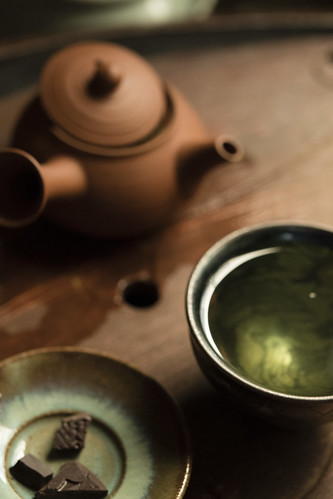
170319 Morning gyokuro & chocolate by debunix, on Flickr
Infusing in Shimizu Ken nosaka kyusu, sipping from Suzuki iron-glaze cup, chocolate on Greenwood studios dish.

Did you cold brew in mineral water? Sounds nice!debunix wrote: More green: sparkling sencha, made with some Tsuen Aoi sencha that was misplaced, and that I pulled out thinking it was the inexpensive sencha that I usually use for this cold brew. Delicious, better than usual with the very fine leaf. Mmm.....
I carefully open an 18 oz bottle of room-temperature Crystal Geyser, use a funnel to drop in about a teaspoon of sencha, tighten the lid back on it, and stick it in the refrigerator. Enjoy 3-24 hours later.victoria3 wrote:Did you cold brew in mineral water? Sounds nice!debunix wrote: More green: sparkling sencha, made with some Tsuen Aoi sencha that was misplaced, and that I pulled out thinking it was the inexpensive sencha that I usually use for this cold brew. Delicious, better than usual with the very fine leaf. Mmm.....
After the tsunami in Japan I decided I would just have to choose tea vendors of Japanese and Chinese teas that seemed trustworthy because I wasn't prepared to give up tea. I buy from the smaller vendors that know their sources, then relax and enjoy.joelbct wrote: ....Pretty solid for the price. If decidedly, not the best I've had, it reminds me how much I like Long Jing, and Chinese Greens in general. I think I stopped drinking them and settled into Sencha due in part to fear of pesticides/lack of environmental regulation in China, which is sad, because Chinese tea is so good, I really don't want to avoid it.
Spring 2017 Cui Ming from Yunnan Sourcing Today, excellent. Going on the reorder list. Crisp, sweet, fresh, clean, vibrant. Amazing that I could, if I wish, get 500g of this for $28+shipping.JRS22 wrote:2017 Chinese greens are on the way!
Are there any tea regions in China without much air pollution? For instance, is my beloved Lu Shan Yun Wu grown and harvested in heavily polluted mountains?chrl42 wrote:I just bought a small package of 2017 first-picked Longjing while strolling the old Shanghai street (400m from my house),
Many of China's green tea-producing areas are air-polluted these days, especially around Yangtze river where LJ is produced...but as a tea lover...can't resist.. shincha
http://aqicn.org/city/china/jiujiang/lushanqixiangtai/Groucho wrote:Are there any tea regions in China without much air pollution? For instance, is my beloved Lu Shan Yun Wu grown and harvested in heavily polluted mountains?chrl42 wrote:I just bought a small package of 2017 first-picked Longjing while strolling the old Shanghai street (400m from my house),
Many of China's green tea-producing areas are air-polluted these days, especially around Yangtze river where LJ is produced...but as a tea lover...can't resist.. shincha
Sent from my SM-G930V using Tapatalk
How is Yunnan, for Blacks/Dian Hong? Simao- have 1kilo of Ning'Er County and Mojiang tea. Also, I wonder, how is Qimen County... I should probably look this stuff up- but it's not just air- also water and soil, and pesticides, I'm concerned about, not sure if there is reliable info on this, or if I even want to know...chrl42 wrote:http://aqicn.org/city/china/jiujiang/lushanqixiangtai/Groucho wrote:Are there any tea regions in China without much air pollution? For instance, is my beloved Lu Shan Yun Wu grown and harvested in heavily polluted mountains?chrl42 wrote:I just bought a small package of 2017 first-picked Longjing while strolling the old Shanghai street (400m from my house),
Many of China's green tea-producing areas are air-polluted these days, especially around Yangtze river where LJ is produced...but as a tea lover...can't resist.. shincha
Sent from my SM-G930V using Tapatalk
A degree for pm 2.5 is currently 91 at Lushan, this is about average air-quality of downtown in medium-sized cities in America, worse than suburbs though.
But it is reletively good air-quality today, normally the city of Jiujiang, pm 2.5 is often go over 150, this degree the newspapers will report if it's in Seoul.
Best air-quality green tea areas I know of are, Huangshan, Zhoushan (buddha tea comes from here), Jiu Hua Shan (another buddha tea)...or some green teas produced from Fujian province perhaps.
Yunnan have been kept clean until this year, normally Yunnan, pm 2.5 was hardly over 50joelbct wrote:How is Yunnan, for Blacks/Dian Hong? Simao- have 1kilo of Ning'Er County and Mojiang tea. Also, I wonder, how is Qimen County... I should probably look this stuff up- but it's not just air- also water and soil, and pesticides, I'm concerned about, not sure if there is reliable info on this, or if I even want to know...chrl42 wrote:http://aqicn.org/city/china/jiujiang/lushanqixiangtai/Groucho wrote:Are there any tea regions in China without much air pollution? For instance, is my beloved Lu Shan Yun Wu grown and harvested in heavily polluted mountains?chrl42 wrote:I just bought a small package of 2017 first-picked Longjing while strolling the old Shanghai street (400m from my house),
Many of China's green tea-producing areas are air-polluted these days, especially around Yangtze river where LJ is produced...but as a tea lover...can't resist.. shincha
Sent from my SM-G930V using Tapatalk
A degree for pm 2.5 is currently 91 at Lushan, this is about average air-quality of downtown in medium-sized cities in America, worse than suburbs though.
But it is reletively good air-quality today, normally the city of Jiujiang, pm 2.5 is often go over 150, this degree the newspapers will report if it's in Seoul.
Best air-quality green tea areas I know of are, Huangshan, Zhoushan (buddha tea comes from here), Jiu Hua Shan (another buddha tea)...or some green teas produced from Fujian province perhaps.
Zhoushan and Jiuhuashan is 2 of China's 4 buddhist mountains (along with E-mei shan and Wutaishan), it's just a name of tea grown on that areas, nothing else.